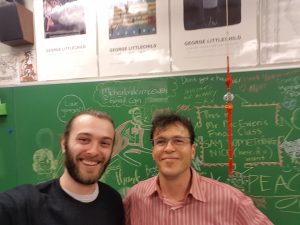
The application from theory to practice that framed my philosophy and commitment to my student’s education was unsurprisingly an evolutionary process with successes sticking and weaknesses being discarded.
Benefits
The attempt to construct lessons that would somehow appeal to individual student interests was quickly discarded in favour of establishing individualized and transferable roles for students within the classroom. Being it that my first (and longest running) pick-up was grade 8 Social Studies, establishing a distinct sense of community was most successful in this scenario. Based on individual student needs and taking into consideration IEPs, ELLs, as well as individual student challenges and strengths I would allocate roles for tasks as simple as agenda checker-offer, to office runner, and note-taker. These individualized roles, that once more could be transferred with the express permission of myself and all involved parties, quickly created a sense of currency in and of the students themselves; they all had a place and a sense of belonging as the foundation of every class from start to finish. This made every moment a moment that they were a part of, effectively reinforcing a sense of worth which in turn appeared to instil a marked sense of confidence and engagement for those present.
Drawbacks
As emphasized above, for those students that were chronically absent for whatever reason; integrating them into the community was more of a challenge. Where one is present from the beginning and has a strong sense of partnership with the class, the other who is absent can feel quite alienated.
Resolve
Resultantly, the best method for integration was not to force the issue as a teacher but to allow the community to establish a place within itself. This was done for one such student and my patience was rewarded by the communities inclinations towards inclusion.
Drawbacks
I learned that part of the success of establishing a strong sense of classroom community weighed on the factors of time, age, and rapport. Where it worked amazingly with the 8s (my first pick up), it worked well with the 11s (my second), and was almost a hindrance to the 12s (third). Having both the time to develop a rapport, routine, and expectations together is critical, and the fact was that the 12s just did not know me as well. Further student’s individual sense of place in the world will always affect engagement and belonging. For my Law 12s I was there teacher, but also just another thing in between themselves and their graduation.
Continuing As A Lifelong Learner
Moving forward as a Teacher I know I won’t be afforded the luxury of time and rapport building during my first professional steps as a TOC. With that in mind I plan to continue developing activities and transitions to maintain senses of belonging, even if briefly, in both the students and myself. One of the most profound realizations I encountered was the power a teacher has to relate. Stepping away from a hierarchical place of authority and instead integrating myself into the classroom community as a Teacher/learner, let students have the opportunity to hold that dichotomy themselves and stay engaged in a growth mindset. Authority and roles never had to be sacrificed and students responded well to an opportunity to inform their fellow community members (myself included) on their ongoing research, interests, and thoughts.